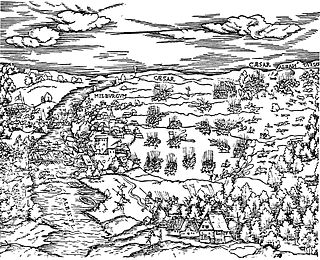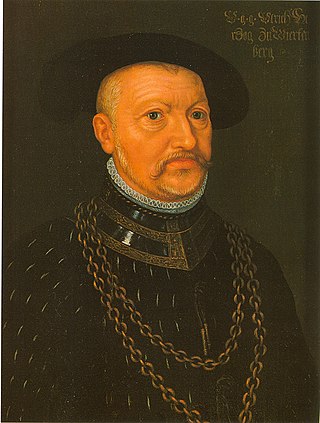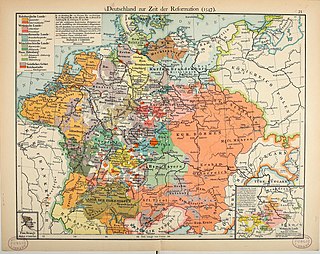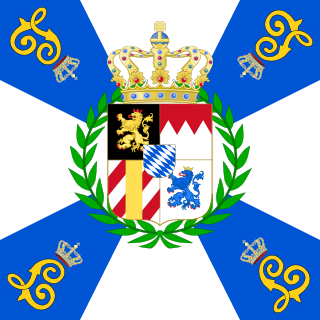
Ingolstadt is an independent city on the Danube, in Upper Bavaria, with 142,308 inhabitants. Around half a million people live in the metropolitan area. Ingolstadt is the second largest city in Upper Bavaria after Munich and the fifth largest city in Bavaria after Munich, Nuremberg, Augsburg and Regensburg. The city passed the mark of 100,000 inhabitants in 1989 and has since been one of the major cities in Germany. After Regensburg, Ingolstadt is the second largest German city on the Danube.

The Schmalkaldic League was a military alliance of Lutheran princes within the Holy Roman Empire during the mid-16th century. It received its name from the town of Schmalkalden, which is located in modern Thuringia.

The Protestant Union, also known as the Evangelical Union, Union of Auhausen, German Union or the Protestant Action Party, was a coalition of Protestant German states. It was formed on 14 May 1608 by Frederick IV, Elector Palatine in order to defend the rights, land and safety of each member. It included both Calvinist and Lutheran states, and dissolved in 1621.

Philip I, Landgrave of Hesse, nicknamed der Großmütige, was a German nobleman and champion of the Protestant Reformation, notable for being one of the most important of the early Protestant rulers in Germany. He was one of the main belligerents in the War of the Katzenelnbogen Succession.

The Battle of Mühlberg took place near Mühlberg in the Electorate of Saxony in 1547, during the Schmalkaldic War. The Catholic princes of the Holy Roman Empire led by the Holy Roman Emperor Charles V decisively defeated the Lutheran Schmalkaldic League of Protestant princes under the command of Elector John Frederick I of Saxony and Landgrave Philip I of Hesse.

The Battle of Rain took place on 15 April 1632 near Rain in Bavaria during the Thirty Years' War. It was fought by a Swedish army under Gustavus Adolphus of Sweden, and a Catholic League force led by Johann Tserclaes, Count of Tilly. The battle resulted in a Swedish victory, while Tilly was severely wounded and later died of his injuries.

The Schmalkaldic War was fought within the territories of the Holy Roman Empire between the allied forces of Charles V, Holy Roman Emperor and Maurice, Duke of Saxony against the Lutheran Schmalkaldic League, with the forces directly loyal to Charles fighting under the command of Fernando Álvarez de Toledo, 3rd Duke of Alba.

Duke Ulrich of Württemberg succeeded his kinsman Eberhard II as Duke of Württemberg in 1498. He was declared of age in 1503. His volatile personality made him infamous, being called the "Swabian Henry VIII" by historians.

Franz Freiherr von Mercy, Lord of Mandre and Collenburg, was a German field marshal in the Thirty Years' War who fought for the Imperial side and was commander-in-chief of the Bavarian army from 1643 to 1645. In that role, he destroyed a French army at Tuttlingen (1643), stalemated another at Freiburg (1644), destroyed a third French army at Herbsthausen (1645) and was killed at the Second Battle of Nördlingen (1645).

The Augsburg Interim was an imperial decree ordered on 15 May 1548 at the 1548 Diet of Augsburg by Charles V, Holy Roman Emperor, who had just defeated the forces of the Protestant Schmalkaldic League in the Schmalkaldic War of 1546/47. Although it ordered Protestants to readopt traditional Catholic beliefs and practices, including the seven Sacraments, it allowed for Protestant clergymen the right to marry and for the laity to receive communion in both kinds. It is considered the first significant step in the process leading to the political and religious legitimization of Protestantism as a valid alternative Christian creed to Roman Catholicism finally realized in the 1552 Peace of Passau and the 1555 Peace of Augsburg. The Interim became Imperial law on 30 June 1548. The Pope advised all bishops to abide by the concessions made to the Protestants in the Interim in August 1549.

William IV was Duke of Bavaria from 1508 to 1550, until 1545 together with his younger brother Louis X, Duke of Bavaria. He was born in Munich to Albert IV and Kunigunde of Austria, a daughter of Emperor Frederick III.
The Second Margrave War was a conflict in the Holy Roman Empire between 1552 and 1555. Instigated by Albert Alcibiades, Margrave of Brandenburg-Kulmbach and Brandenburg-Bayreuth, who was attempting to form a Duchy of Franconia under his rule, the war resulted in widespread devastation in Franconia, while also affecting the Rhineland and Lower Saxony.

The Electorate of Bavaria was a quasi-independent hereditary electorate of the Holy Roman Empire from 1623 to 1806, when it was succeeded by the Kingdom of Bavaria.

Anna of Austria, a member of the Imperial House of Habsburg, was Duchess of Bavaria from 1550 until 1579, by her marriage with Duke Albert V.

The Bavarian Army was the army of the Electorate (1682–1806) and then Kingdom (1806–1918) of Bavaria. It existed from 1682 as the standing army of Bavaria until the merger of the military sovereignty of Bavaria into that of the German State in 1919. The Bavarian Army was never comparable to the armies of the Great Powers of the 19th century, but it did provide the Wittelsbach dynasty with sufficient scope of action, in the context of effective alliance politics, to transform Bavaria from a territorially-disjointed small state to the second-largest state of the German Empire after Prussia.

The Kreuztor, built in 1385, is the western gateway to the medieval city center of Ingolstadt. The tower's name is derived from the leper house belonging to the Church of the Holy Cross, which stood to the west of the city walls until its destruction in the Schmalkaldic War in 1546.
Philip III, Count of Nassau-Weilburg was a Count of the Nassau-Weilburg. Among his major achievements were the introduction of the Reformation, the foundation of the Gymnasium Philippinum in Weilburg and the start of the construction of Schloss Weilburg.

The Second Schmalkaldic War, also known as the Princes' Revolt, was an uprising of German Protestant princes led by elector Maurice of Saxony against the Catholic emperor Charles V that broke out in 1552. Historians disagree whether the war concluded the same year with the Peace of Passau in August, or dragged on until the Peace of Augsburg in September 1555. The Protestant princes were supported by King Henry II of France, who was a Catholic, but sought to use the opportunity to expand his territory in modern-day Lorraine.

The Bayerisches Armeemuseum is the Military History Museum of Bavaria. It was founded in 1879 in Munich and is located in Ingolstadt since 1972. The main collection is housed in the New Castle, the permanent exhibition about the First World War in Reduit Tilly opened in 1994 and the Armeemuseum incorporated the Bayerisches Polizeimuseum in the Turm Triva in 2012. Today, part of the former Munich Museum building is the central building of the new Bayerische Staatskanzlei.

The siege of Philippsburg was a French siege of the Rhine fortress of Philippsburg during the Thirty Years' War. After the battle of Freiburg in early August, the French under the Duc d'Enghien refrained from attacking the city and marched north to besiege the imperial-held Philippsburg instead. The place fell after a two-week siege.


















